Apnea: keep your breath!
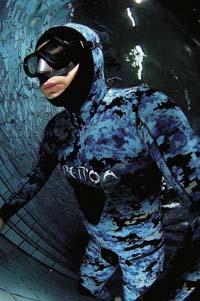
11 minutes 35 seconds. The perception of time varies according to circumstances. 11 minutes and 35 seconds without breathing, which takes a long time, especially for those who see it.
Concentration and tranquility are essential to practice apnea sports and control. They precede a static apnea test to a heating. It is not about heating the muscles, but only a few stretches are made. The formation focuses on breathing, relaxing and preparing the body to store oxygen as effectively as possible. The time before the start of the test is decisive: they must expel carbon dioxide from the body and ingest as much oxygen as possible; after deep breaths, the deepest, the last -- they inject as much air as possible in the lungs.
Asier Eraso practices apnea sport, is champion of apnea of Euskadi and more than five and a half minutes ago without breathing. "Seen from the outside, it looks hard," he says, "you see a guy without moving into the pool and in the end it's long. But when you're stuck, you're concentrated and time doesn't get so long."
The concentration is essential. According to Eraso "it is very mental. And you have to get to relax a lot, like sleeping a little, relax the muscles and thus reduce the consumption of oxygen". The stacker remains motionless in the test. To make sure it's okay, the judge once asks for a signal: he plays in his hand and the apneal makes a gesture with his hand as a response, the movement must be clear. If the answer is slow, things can go wrong.
Relaxation decreases heart rate. And contact with water increases. "If it is a reflex, apparently facial," explains the doctor Iñigo Arrangi. "When you come into contact with water on your face, when you come in contact with water colder than body temperature, a bradycardia occurs, the heart rate decreases and the pulses decrease. Then, the heart works less to spend less oxygen."
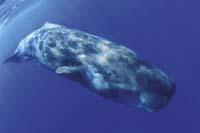
When you do not breathe, the feeling is not sweet. "It's like torture," continues Arrangi. As oxygen is burned in the body, carbon dioxide is produced. "In the neck, in the carotid artery, we have receptors that measure the partial pressure of carbon dioxide in blood. When that pressure rises, the time comes when we thirst to breathe." Pre-test preparation in static apnea aims to delay this respiratory thirst. Remove the carbon dioxide stored in the body and accumulate as much oxygen as possible, which is stored in the hemoglobin of the blood and, above all, in the lungs. In this way the need to renew the oxygen is delayed and it is done longer without the need to go to breathe under water.
Respiratory thirst is a survival mechanism. By voluntary decision not to breathe, as oxygen decreases and carbon dioxide increases, before it becomes severe, the body makes strength to extend the pulmonary bellows. The freighter trains to delay that moment. The best training for the extension of apnea is the practice of apneas.
However, the delay of thirst has a limit. If life is delayed until endangered, the brain launches a second mechanism: knowledge is lost and the vegetative nervous system takes control, that is, it starts breathing. If this occurs in water, of course, there is a risk of drowning.
"Anyway, one must leave a clear thing", stresses Arrangi: "When we say it has made an apnea of five minutes, it is not that it has taken five minutes to lack oxygen, but has been without breathing because oxygen is stored in the body."
Actuates the fins
In static apnea, the consumption of oxygen is minimal, since there is no movement. But just starting to swim the situation changes a lot. The muscles burn oxygen, so the movement should be as efficient as possible: if it is not too fast, the muscles burn oxygen faster and the respiratory thirst appears before, but if it is too slow it can last longer, but it can be short. In dynamic apnea, that is, when swimming under water, each apneal seeks its rhythm to travel as far as possible without taking the surface of the water. In dynamic apnea, the technique and ability to swim is worth as much as staying long without breathing.
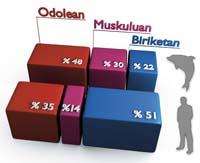
Both dynamic apnea and static are performed in the pool. But there are other tests of apnea that must be performed obligatorily at sea because the depth of the pool is not enough. The last world championship, for example, was held last December in a bay in the Bahamas, in a 202-metre underwater pit.
The aim of these tests is to descend to as deep as possible: with or without fins, with the help of sinking floors, or taking a rope as a guide... there are several modalities.
In the No limit mode -- which sinks with the help of the ballast and return on their own -, the apneal Herbert Nitsch has the world record: It descends to 214 meters of depth in June 2007. No one has ever descended further down with a single breath and has returned well without losing knowledge. In fact, the regulation of apnea is very clear in this, the test does not end until completion of the final protocol. In this protocol, the athlete must perform a gesture well with the big finger and the index united, with the head clear and without coordination problems.
Herbert Nitsch himself knows what it is to be out of competition for failure in the protocol: In the Bahamas world championship he tried to beat the world record in the mode without fins. It reached the depth target of 89 meters. After an immersion of 3 minutes and 40 seconds, he appeared with difficulties of focus and the judges did not accept him. He was followed by William Trubridge. It dropped to 90 meters and met the protocol clearly. The world record was won by Trubridge.
The sperm whale, this envy!
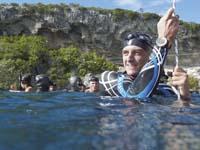
When going down to the bottom of the sea, in addition to the lack of air, another weight factor comes into play: the pressure exerted by water. At greater depth, greater is the water block on which the body sits, more load. Other mammals have remedy this problem, they have adapted to avoid so much pressure. They are marine mammals, excellent apneales, especially cetaceans. Its apnea capacity is its own. They have hydrodynamic bodies adapted to water and prolonged diving capacity.
To begin with, cetaceans have no respiratory thirst like human. Inspiration is voluntary and does not reflect. Therefore, these animals cannot be anesthetized without mechanical ventilation, since they stop breathing.
The best apneal in the world is undoubtedly a sperm whale, according to marine biologist Isabel Guzmán. "It can be an hour and a half under the water and dive up to 3,000 meters deep. That's amazing! ". The sperm whale is completely adapted to this medium. The pressure does not affect as much as we do. "The problem is that the volume of air this animal receives is proportionally very small compared to its mass. Its cavity, full of air, is practically null, compressed by the pressure, which prevents it from being applied".
Unlike the sperm whale, the human body can proportionally assimilate a lot of air. An apneal can easily take between seven and eight liters of air in a deep breath. This air is compressed by high pressure (compresses the lungs), which allows the gases accumulated in the lungs (oxygen, carbon dioxide and nitrogen) to pass into the blood forming gas bubbles and causing embolism. No, the human body is not made to withstand great pressures.
As the depth drops, the water temperature decreases. All mammals lose heat from the extremities. "The feet and hands are cooled first," says Guzman, "and the cetaceans do the same: they lose heat from the pectoral fins and tail." To avoid this, the sperm whale practically interrupts the circulation of the extremities through vasoconstriction, that is, narrowing the blood vessels. It limits blood flow to the brain and heart, meaning "the cost of oxygen is minimal because you don't need to feed a lot of cells."
Although it is not so radical, the human body also has a mechanism in a state of apnea. Doctor Iñigo Arrangi explains that "there is a redistribution of oxygen: blood does not go to all sites, but to vital places". However, Guzman explains that "the expenditure of oxygen that makes the sperm cell is minimal with respect to ours".
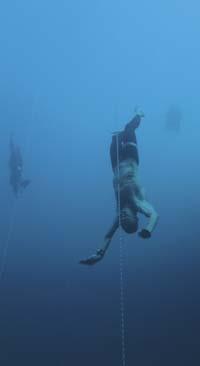
The sperm whale provokes the admiration of the apneales on many sides. "We would take its characteristics," says Guzman, recognizing his envy as a diver. "It uses much better oxygen than us. Normally, it comes out to the surface and performs three or four breaths, and then sinks again. During the breaths it uses 90% of the lung capacity -- we about 15% -- and takes advantage of 12% of the oxygen of the air it breathes -- we only 4%. The difference is huge! ".
Thus, it has three breaths sufficient to completely restore the oxygen of the body. For this renewal it is essential to remove mirabilia, a capillary network in which the human being also has it, but that of the cetaceans in general is very wide, which facilitates the diffusion of the oxygen to all the cells and facilitates the access to the lungs of the venous blood, carbon dioxide.
The difference between sperm whale and man is unsurpassed, but the preparation of apneal helps to enjoy the underwater world. Asier Eraso makes it clear: "I like to go in the water and the sensations are very beautiful. When you're in the water, being prepared gives you another peace of mind."
Buletina
Bidali zure helbide elektronikoa eta jaso asteroko buletina zure sarrera-ontzian











